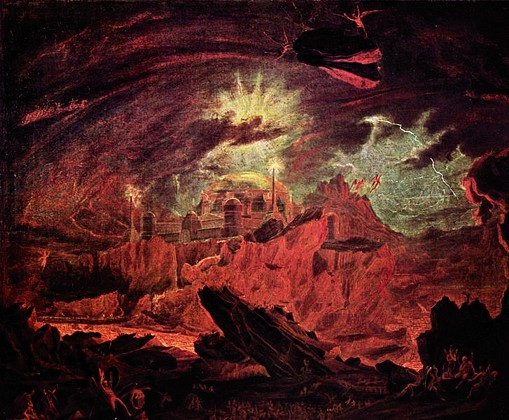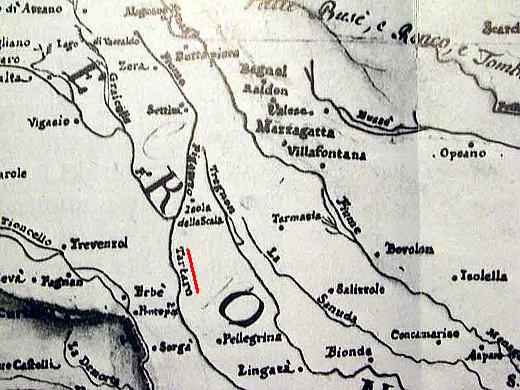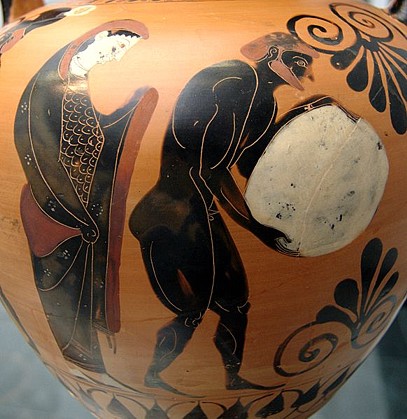Lessico
Tartaro

Angeli
caduti nell'Inferno – 1841
John Martin (1789-1854)
In greco Tártaros.
Luogo della cosmologia mitica greca: č la parte piů profonda degli Inferi,
quasi un “cielo” degli Inferi situato agli antipodi del Cielo che sovrasta
la Terra e distante dagli Inferi quanto il Cielo dista dalla Terra. Avendo gli
dei come sede il Cielo, gli anti-dei (o la generazione divina sconfitta e
cacciata dal Cielo dagli dei attuali) hanno il Tartaro come sede. Il Tartaro
č stato anche personificato come un essere primordiale coevo di Gaia![]() (la
Terra), con cui si accoppia generando mostri quali Echidna e Tifone.
(la
Terra), con cui si accoppia generando mostri quali Echidna e Tifone.
A quanto pare il Tartaro č stato in grado di dare il nome di tartaruga alla testuggine, detta in latino classico sia testudo (testa era il guscio di questo rettile) che chelys, mentre in greco antico suonava chélys oppure chelřnë. Oggi con testuggine si indicano le specie terrestri dell'ordine Testudines o Chelonia, come per esempio la Testuggine di terra o Testudo hermanni, mentre con tartaruga si indicano comunemente le specie acquatiche, come per esempio la Tartaruga marina comune o Caretta caretta.
Il latino cristiano, molto piů tardivo del classico, invece di testudo ha tartaruca, attestata in una tavoletta imprecatoria di Traů in Croazia (Diehl, Inscriptiones Lat. Christ. Vet. 2389a), e tartaruca deriverebbe dal greco tardo tartaroűchos, nome di uno spirito infernale (appunto da Tártaros ‘inferno’ e dal verbo échein col significato di abitare), che appare per la prima volta in un papiro magico. Nel simbolismo cristiano la tartaruga rappresentava lo spirito delle tenebre, del male. Questa ipotesi, proposta nel 1930 dall'archeologo austriaco Rudolf Egger (ora in Römische Antike und frühes Christentum, I, Klagenfurt, 1962, pp. 144-158) e suffragata da molti elementi iconografici, č stata generalmente accolta dagli studiosi.

Tartaruga marina comune - Caretta caretta
Tartaro
La parola Tartaro, in greco Tártaros,
indica il luogo dove, nella Mitologia greca e Latina, Zeus![]() (per i latini
Giove) aveva rinchiuso i Titani
(per i latini
Giove) aveva rinchiuso i Titani![]() , mostruosa stirpe di esseri
sovrumani che aveva tentato di spodestare gli dei dall'Olimpo (Titanomachia)
per sottrarre il primato a questi ultimi. I Titani vennero cosě sconfitti da
Zeus e da altri personaggi mitologici e rinchiusi nel Tartaro, che secondo la
visione greca si trova sempre sotto terra ma č comunque distinto dall'Ade,
l'inferno dei defunti umani. Il Tartaro č identificato come una voragine buia
e talmente profonda che lasciando cadere un'incudine questa impiegava nove
giorni e nove notti a toccare il fondo.
, mostruosa stirpe di esseri
sovrumani che aveva tentato di spodestare gli dei dall'Olimpo (Titanomachia)
per sottrarre il primato a questi ultimi. I Titani vennero cosě sconfitti da
Zeus e da altri personaggi mitologici e rinchiusi nel Tartaro, che secondo la
visione greca si trova sempre sotto terra ma č comunque distinto dall'Ade,
l'inferno dei defunti umani. Il Tartaro č identificato come una voragine buia
e talmente profonda che lasciando cadere un'incudine questa impiegava nove
giorni e nove notti a toccare il fondo.
Il nome Tartaro fu impiegato talvolta come sinonimo di Ade o di mondo sotterraneo in generale, ma soprattutto per designare il luogo di dannazione dei malvagi dopo la morte. Peccatori leggendari come Issione, re dei Lapiti, Sisifo, re di Corinto, e Tantalo, figlio mortale di Zeus, erano condannati a risiedere per l'eternitŕ nel Tartaro.
Successivamente la parola
Tartaro venne confusa e assimilata a una generica definizione di inferno: giŕ
con Virgilio![]() che, nell'Eneide, divide
gli inferi fra Tartaro e Campi Elisi. Mentre A.R. Hope Moncrieff indica ancora
Teseo imprigionato nell'Ade e non nel Tartaro insieme a Piritoo.
che, nell'Eneide, divide
gli inferi fra Tartaro e Campi Elisi. Mentre A.R. Hope Moncrieff indica ancora
Teseo imprigionato nell'Ade e non nel Tartaro insieme a Piritoo.
Nell'inferno vi erano cinque
fiumi: Stige, Cocito, Acheronte, Flegetonte e Lete, l'acqua di quest'ultimo
aveva la caratteristica di far perdere la memoria a chi la beveva. L'anima del
defunto che ivi entrava, dopo aver attraversato l'Acheronte, doveva versare un
obolo al terribile Caronte e raggiungere i tre giudici Minosse, Eaco e
Radamanto![]() i quali emettevano il loro
verdetto. A guardia dell'ingresso degli inferi vi era Cerbero, enorme cane a
tre teste.
i quali emettevano il loro
verdetto. A guardia dell'ingresso degli inferi vi era Cerbero, enorme cane a
tre teste.
Fiume Tartaro

Corso del fiume Tartaro e dei suoi diversivi in territorio veronese e mantovano. Mappa di Ignazio Avesani, 1795. Al centro si legge: Tarmasia. Notare il dosso di Campolongo circondato dal fiume Menago e le propaggini dei Dugali del Tormine confluenti in quello che oggi č il Menaghetto di Tarmassia (Menacus Vetus).
www.tarmassia.it
In classic Greek mythology, below Heaven, Earth, and Pontus is Tartarus, or Tartaros (Greek Tártaros, deep place). It is either a deep, gloomy place, a pit or abyss used as a dungeon of torment and suffering that resides within Hades (the entire underworld) with Tartarus being the hellish component. In the Gorgias, Plato (c. 400 BC) wrote that souls were judged after death and those who received punishment were sent to Tartarus. As a place of punishment, it can be considered a hell. The classic Hades, on the other hand, is more similar to Old Testament Sheol. Like other primal entities (such as the earth and time), Tartarus is also a primordial force or deity.
Tartarus in Greek Mythology
In Greek mythology, Tartarus is both a deity and a place in the underworld even lower than Hades. In ancient Orphic sources and in the mystery schools Tartaros is also the unbounded first-existing "thing" from which the Light and the cosmos is born. In Hesiod's Theogony, c. 700 BC, the deity Tartarus was the third force to manifest in the yawning void of Chaos.
As for the place, the Greek poet Hesiod asserts that a bronze anvil falling from heaven would fall 9 days before it reached the Earth. The anvil would take nine more days to fall from Earth to Tartarus, making it approximately 40,000 miles deep. In The Iliad (c. 700), Zeus asserts that Tartarus is "as far beneath Hades as heaven is high above the earth." As a place so far from the sun and so deep in the earth, Tartarus is hemmed in by three layers of night, which surround a Beryllium wall which in turn encompasses Tartarus. It is a dank and wretched pit engulfed in murky gloom. It is one of the primordial objects which sprung from Chaos, the Abyss. Along with Tartarus, Gaia (Earth), and Eros, emerged into the universe.
While, according to Greek mythology, Hades is the place of the dead, Tartarus also has a number of inhabitants. When Kronos, the ruling Titan, came to power he imprisoned the Cyclopes in Tartarus. Some myths also say he imprisoned the three Hecatonchires (giants with fifty heads and one hundred arms). Zeus released them, and defeated Kampe, to aid in his conflict with the Titan giants. The gods of Olympus eventually defeated the Titans. Many, but not all of the Titans, were cast into Tartarus. Epimetheus, Metis, Menoetius, and Prometheus are some Titans who were not banished to Tartarus. Cronus, father of the big three, was imprisoned on Tartarus. In Tartarus, prisoners were guarded by the Hecatonchires. Later, when Zeus overcame the monster Typhon, the offspring of Tartarus and Gaia, he threw the monster into the same pit.

Persephone![]() supervising Sisyphus in the Underworld
supervising Sisyphus in the Underworld
Attic black-figure amphora, ca. 530 BC
Originally, Tartarus was used only to confine dangers to the gods of Olympus. In later mythologies, Tartarus became the place where the punishment fits the crime. For example Sisyphus, who was punished for telling the father of Aegina, a young woman kidnapped by Zeus for one of his sexual gratifications, where she was and who had initially taken her. Zeus considered this an ultimate betrayal and saw to it that Sisyphus was forced to roll a large boulder up a mountainside, which, when he reached the crest, rolled back down, again and again.
Also found there was Ixion, one of the mortals invited to dine with the gods. Ixion began to lust after Zeus' wife, Hera, and began to caress her under the table, but soon ceased at Zeus' warning. Later that night, having given Ixion a place to sleep, Zeus felt the need to test the guest's tolerance and willpower. Constructing a cloud-woman to mirror Hera in appearance, Zeus sent her, known as Nephele, to Ixion's bed. He promptly slept with and impregnated the false Hera. As his punishment, he was banished to Tartarus to forever roll strapped to a wheel of flames, which represented his burning lust.
Tantalus who was also graciously invited to dine with the gods, felt he should repay them for their kindness and hospitality, but in his pride, decided to see if he could deceive the gods. Tantalus murdered and roasted his son Pelops as a feast for the gods. Demeter, one of the goddesses who preferred to walk with the mortals, graciously accepted the food, but was immediately repulsed when she bit into the left shoulder. The gods all became violently ill and immediately left for Mt. Olympus. As his punishment for such a heinous act, Tantalus was chained to a rock in the middle of a river in Tartarus with a berry bush hanging just out of reach above his head. Cursed with unquenchable thirst and unending hunger, Tantalus constantly tried to reach the water or food, but each time, the water and berries would recede out of his reach for eternity. It is from Tantalus's name and torment that we derive the English word 'Tantalise'.
According to Plato (c. 400), Rhadamanthus, Aeacus and Minos were the judges of the dead and chose who went to Tartarus. Rhadamanthus judged Asian souls; Aeacus judged European souls and Minos was the deciding vote and judge of the Greek. Plato also proposes the concept that sinners were cast under the ground to be punished in accordance with their sins the Myth of Er.
Roman Mythology's Tartarus
In Roman mythology, Tartarus is the place where sinners are sent. Virgil describes it in the Aeneid as a gigantic place, surrounded by the flaming river Phlegethon and triple walls to prevent sinners from escaping from it. It is guarded by a hydra with fifty black gaping jaws, which sits at a screeching gate protected by columns of solid adamantine, a substance akin to diamond - so hard that nothing will cut through it. Inside, there is a castle with wide walls, and a tall iron turret. Tisiphone, one of the Erinyes who represents revenge, stands guard sleepless at the top of this turret lashing a whip. There is a pit inside which is said to extend down into the earth twice as far as the distance from the lands of the living to Olympus. At the bottom of this pit lie the Titans, the twin sons of Aloeus and many other sinners. Still more sinners are contained inside Tartarus, with punishments similar to those of Greek myth.
New Testament
The term "Tartarus" is found only once in the Bible, at 2 Peter 2:4: "God did not hold back from punishing the angels that sinned, but, by throwing them into Tartarus, delivered them into pits of dense darkness to be reserved for judgment." The Book of Enoch, chapter XX, verse 2 specifically states that Tartarus is the place in which the angels who cohabited with women in Genesis 6 are to be reserved for judgment. It would seem to be a synonym of the "Abyss". In Luke 8:31, the Legion of demons beg Jesus not to send them to the Abyss. "The Beast" of Revelation, will come up out of the Abyss (Revelation 11:7; 17:8). Satan will be thrown into the Abyss for 1000 years (Revelation 20:3).
The term "Hades" appears in the religious texts of New Testament times as a translation of the Old Testament Sheol. In most English Bibles, the word Tartarus is simply translated as Hell, even though early Christian writers usually used the term Gehenna, the fiery pit, to mean hell. In some sense, this dark place matches the term's traditional meaning, a dark pit in which the Supreme God has cast his spirit enemies. But it is separate from the Lake of Fire, which is the place of eternal fiery punishment that most people think of when they think of "Hell". This is evidenced in Revelation 20, where Satan is released from the Abyss (v. 3) and later thrown in the "Lake of Burning Sulfur" (v. 10), where he will be "tormented day and night forever and ever".